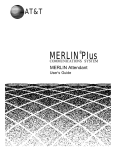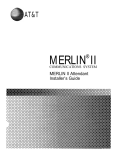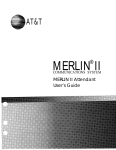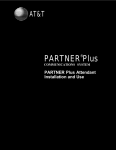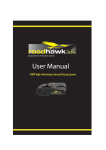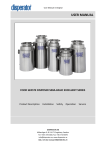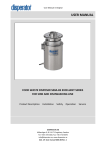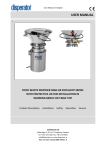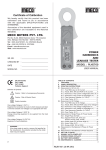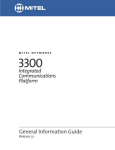Download AT&T SPIRIT Attendant ConnecT/R User`s guide
Transcript
AT&T SPIRIT ® Communications System SPIRIT Attendant Installer’s Guide SPIRIT is a registered trademark of AT&T. Copyright © 1991 by AT&T All Rights Reserved Printed in the United States of America Document Order No. 518-453-711 April 1991 Issue 1 Notice: The information in this document is subject to change without notice. AT&T assumes no responsibility for any errors that may appear in this document. Contents Section 1: Installation Requirements Overview Equipment and Location Requirements Administration Procedures Connecting the SPIRIT Attendant 1-1 1-5 1-7 1-8 Section 2: Initial Programming Programming Features 2-1 Section 3: Testing and Troubleshooting Testing Troubleshooting 3-1 3-2 Index IN-1 Index List of Tables Table Page 1-1 1-2 1-3 1-4 1-5 Meaning of Power and Battery Lights Meaning of Setup Switch Settings Calls Per Hour Table Incoming Lines Table Switch Settings When Operating Unit 1-2 1-3 1-5 1-6 1-10 2-1 2-2 Announcement Time Allocations Call Processing Options 2-4 2-10 3-1 3-2 Out-of-Service Codes Pinout Assignment For the TI 700 or AT&T 475 Printer 3-3 3-5 List of Figures Figure Page 1-1 1-2 1-3 1-4 Front View of the SPIRIT Attendant Back View of the SPIRIT Attendant Setup Switch Positions for Installing Unit Connecting two SPIRIT Attendants 1-2 1-3 1-9 1-11 2-1 2-2 Blind Transfer Process Immediate and Backup Call Handling 2-7 2-8 FCC Notification Information Interference Information Federal Communications Commission (FCC) Rules require that you be notified of the following: ● ● ● ● ● This equipment generates, uses, and can radiate radio frequency energy and, if not installed and used in accordance with the instructions in this manual, may cause interference to radio communications. This equipment has been tested and found to comply with the limits for a Class A computing device pursuant to Subpart J of Part 15 of FCC rules, which are designed to provide reasonable protection against such interference when operated in a commercial environment. Operating this equipment in a residential area is likely to cause interference with radio communications, in which case the user, at his or her own expense, will be required to do whatever is necessary to correct the interference. The SPIRIT Attendant is designed to be connected to the SPIRIT system control unit using a SPIRIT Attendant ConnecT/R. The SPIRIT Attendant is not intended to be connected directly to the network. The SPIRIT Attendant is a separately registered device. — FCC registration number: GRM3U8-19187-CIE Section 1: Installation Requirements Overview The SPIRIT Attendant answers incoming calls on designated lines with a prerecorded message and directs callers to the appropriate extension in the SPIRIT Communications System. This equipment can: ● reduce the workload of the receptionist ● insure incoming calls are answered during peak calling periods ● answer incoming calls after business hours and on holidays and weekends CAUTION: The SPIRIT Attendant operates only with the SPIRIT system and a SPIRIT Attendant ConnecT/R (118B) connected to a SPIRIT system station port. Key Features Some of the key features of the SPIRIT Attendant are: ● ● ● ● ● Security Code An authorized caller code that must be entered before changing any programmable features to protect recorded announcements and other programming from being changed by unauthorized personnel. Remote Programmability Features, including recorded announcements, can be programmed from a Touch-Tone phone either on-site or from a remote location. Day/Night/Hold Announcements Specific greetings can be played to callers in response to the time of day or the status of the call. System Clock/Weekly Calendar An internal clock and calendar can track business hours and days of operation to allow the appropriate announcement to be played to callers. Battery Backup Routing plans and programming parameters can be saved up to eight weeks following a power outage, provided the battery is fully charged. Recorded announcements can be saved up to three hours under the same conditions. Installation Requirements 1-1 Front Panel There are three lights on the front panel as shown in Figure 1-1. The lights indicate the following: Lights when ac power is on Attendant AT& T power Blinking light indicates a problem. See "Troubleshooting" battery taking Lights when SPIRIT Attendant answers and monitors calls Steady light indicates battery is fully charged (when power light is on) Light off when battery is not fully charged FIGURE 1-l. Front View of the SPIRIT Attendant. ● ● power SPIRIT Attendant is connected to a power source when this light is on. battery Table 1-1 describes the meaning of the different light combinations when ac power is connected: TABLE 1-1. Meaning of Power and Battery Lights. ● 1-2 Installation Requirements Power Light Battery Light On Off Battery charging On On Battery fully charged Off On Unit operating on battery power Off Off Unit not operating; refer to "Troubleshooting" On Blinking Out of Service code; refer to “Troubleshooting” Description talking This light is on whenever the SPIRIT Attendant answers and monitors a call. Back Panel The connectors and four setup switches on the back panel are shown in Figure 1-2. AT&T audio off on reset FIGURE 1-2. ● ● setup 10VAC serial i/o out reserved to line Back View of the SPIRIT Attendant. reset This recessed button resets the SPIRIT Attendant. See "Troubleshooting" for details. setup switches There are four setup switches. Switches 1, 2, and 3 control the SPIRIT Attendant response to a power outage as shown in Table 1-2; switch 4 is not used. TABLE 1-2. Meaning of Setup Switch Settings. Switch On (Down) Off (Up) 1 Recorded announcements are retained during a power outage Recorded announcements are erased during a power outage 2 Routes and other programming parameters are retained during a power outage Routes and other programming parameters are reset to defaults during a power outage 3 The SPIRIT Attendant continues to answer calls during a power outage The SPIRIT Attendant does not answer calls during a power outage 4 Not Used Not Used Installation Requirements 1-3 CAUTION: After connecting ac power to the SPIRIT Attendant, be sure that switches 1 and 2 are on (down). With this setting, recorded announcements are saved up to three hours during a power outage (if the battery is fully charged) and routing plans and programming parameters are retained up to eight weeks. ● ● ● ● ● 1-4 Installation Requirements 10 VAC This is the power connection. serial i/o This is the connection for the printer to perform diagnostic tests. audio out Not used reserved Not used to line This connects the SPIRIT Attendant with the SPIRIT Attendant ConnecT/R (118B) that connects to a station port on the SPIRIT system control unit. Equipment and Location Requirements The following equipment is supplied with the SPIRIT Attendant: ● Power cord with transformer ● 8-foot, 4-wire modular phone cord ● Mounting plate ● User’s Guide ● SPIRIT Attendant ConnecT/R (118B) The 118B must be connected to a station port in the SPIRIT system control unit. Up to four SPIRIT Attendant units (connected to four 118Bs) can be connected to the system. Number of SPIRIT Attendants Required If a customer is using the SPIRIT Attendant only for backup call handling or after hours, only one SPIRIT Attendant is required unless call traffic is heavy, as shown in Table 1-3. When call traffic is heavy, the number of SPIRIT Attendants required at a site depends on the number of calls the customer receives during peak hours. Refer to Table 1-3 to determine how many SPIRIT Attendants are required. TABLE 1-3. Calls Per Hour Table. Calls Per Hour Number of Units Needed 15 1 15 - 30 2 30 - 45 3 more than 45 4 If the customer does not know the number of calls the business gets during peak hours, you can estimate how many SPIRIT Attendants are required by asking the customer how many incoming lines the business has. Then refer to Table 1-4 to determine the number of SPIRIT Attendants required. Installation Requirements 1-5 TABLE 1-4. Incoming Lines Table. Number of Lines Number of Units Needed 3 or fewer 1 4-6 2 6-8 3 8 - 10 4 The number of units needed can also be affected by the type of calls a customer receives. If there is significant overflow of unanswered calls to the receptionist, an additional SPIRIT Attendant may be needed. Location The location for the SPIRIT Attendant must meet the following criteria: ● Within 5 feet of a properly grounded AC power source that is not controlled by a switch NOTE: ● ● 1-6 Installation Requirements If possible, the SPIRIT Attendant should share the same power source with the SPIRIT system control unit. This is recommended when the SPIRIT system control unit is connected to an Uninterruptible Power Supply (UPS). Not more than 10 feet away from the SPIRIT system control unit A sufficient distance away from a heating or cooling source to prevent exposure to temperatures beyond 32 °F to 104 °F (0 °C to 40 °C) Administration Procedures Before installing a SPIRIT Attendant, you must install and administer a SPIRIT Attendant ConnecT/R (118B) for each unit you are connecting. Perform all the appropriate administration procedures from a SPIRIT system telephone that is connected to the SPIRIT system control unit. (Refer to the SPIRIT Administration Manual.) Attendant Station Port Programming Immediate Call Handling Backup Call Handling Transfer to Multiple Stations Use the following procedure to administer the SPIRIT system so that the SPIRIT Attendant can access common lines. 1. Program all lines for “answer only” at the station port that the SPIRIT Attendant will be connected to. 2. When installing with a 1224/2448 SPIRIT, program only common lines for “line button assigned” at the station port that the SPIRIT Attendant will be connected to. 3. Program any personal lines for “no permission” at the SPIRIT Attendant. 4. If “night service” is used, insure that the SPIRIT Attendant port is set for “custom ringing.” Use the following procedure to administer the SPIRIT Attendant for immediate call handling in the SPIRIT system: 1. Program all common lines for “delayed ring” at the receptionist’s voice terminal. 2. Program all common lines for “no ring” or “delayed ring” at all other stations. 3. Program all common lines for “normal ring” at the SPIRIT Attendant. Use the following procedure to administer the SPIRIT Attendant for backup call handling in the SPIRIT system: 1. Program all common lines for “normal ring” at receptionist(s) voice terminal(s). 2. Program all common lines for “no ring” or “delayed ring” at all other stations. 3. Program all common lines for “delayed ring” at the SPIRIT Attendant. This provides a 3-ring delay (approximately 12 seconds) at the SPIRIT Attendant. If a greater delay is needed, use the SPIRIT Attendant Day/Night Delay to provide additional delay over 3 rings. 4. Program Day and/or Night Answer Delay as required on the SPIRIT Attendant. The SPIRIT Attendant can transfer an incoming call to only one destination extension. If the destination actually should be one of several extensions, such as several people answering calls in a parts department, a common alerter could be installed. Choose an unused station port and administer all CO lines to be “answer only” and “no ring.” On 1224/2448 SPIRIT Systems, administer the common lines for “line button assigned.” Installation Requirements 1-7 Install a ConnecT/R (118A) with an alerter (such as AUXILIARY TONE RINGER Comcode 105446546) connected to the TEL-DEVICE connector. Program a route in the SPIRIT Attendant to transfer all calls intended for the parts department to the extension number of the station port where the alerter is connected. Any of the personnel in the parts department can access the incoming call that is alerting by pressing “INTERCOM ✳ 8 XX”, where the XX is the extension number of the common alerter. The ” ✳ 8 XX” can be programed into a SPEEDCALL location on the station set and the button could be labeled “CALL PICKUP.” Transfer to an Answering Machine Choose an unused station port and administer all CO lines to be “answer only” and “no ring.” On 1224/2448 SPIRIT Systems, administer the common lines for “line button assigned.” Install a ConnecT/R (118A) with an answering machine (such as the AT&T Model 1321 or 1323) connected to the TEL-DEVICE connector. Program a route on the SPIRIT Attendant to transfer all calls intended for the answering machine to the extension number of the station port where the ConnecT/R is connected. Include some text in the SPIRIT Attendant’s message instructing the caller to “Dial X to leave a message.” 1-8 Installation Requirements Connecting the SPIRIT Attendant CAUTION: Before initial installation of the SPIRIT Attendant, set switches 1 and 2 on the back panel to off (up). Follow the steps below to install the SPIRIT Attendant: FIGURE 1-3. Setup Switch Positions for Installing Unit. 1. For each SPIRIT Attendant port: a. Install a SPIRIT Attendant ConnecT/R (118B) on the SPIRIT system control unit. 2. Place the SPIRIT Attendant on a table or desktop, or mount it using the mounting bracket: a. Using a #10 or smaller screw (wood, sheet metal, concrete), attach the wall mounting bracket to a vertical wall surface so that the hook end of the bracket is down. b. Locate the keyhole opening on the underside of the SPIRIT Attendant with the hook on the bracket. Slide the unit over the hook and down to secure. CAUTION: Do not stack multiple SPIRIT Attendants; this will damage the units. 3. Make sure setup switches 1 and 2 are off, then plug one end of the modular phone cord into the jack on the back of the SPIRIT Attendant labeled “to line.” (See Figure 1-3.) 4. Plug the other end of the modular phone cord into the 118B jack labeled “TEL DEVICE.” (See Figure 1-4.) Installation Requirements 1-9 5. Plug one end of the power cord into the 10 VAC power connection on the SPIRIT Attendant. 6. Plug the other end into a 120 VAC outlet. The power light goes on. If the battery light flashes, announcements have not been programmed. (For a complete description of error codes, see Table 3-1 on page 3-3.) 7. Reset the setup switches as described in Table 1-5. TABLE 1-5. Switch Settings When Operating Unit. Switch NOTE: 1-10 Installation Requirements Result Setting 1 On Saves recorded announcements during power outage 2 On Saves routes and programmable features during power outage 3 Off Does not use battery backup to answer calls during power outage (See NOTE) 4 Off Not used During a power outage there is no need to use battery backup to answer calls if the SPIRIT Attendant shares an Uninterruptible Power Supply (UPS) with the SPIRIT system control unit. If a UPS is not used with the control unit, incoming calls cannot be answered by the system during a power failure and therefore cannot be directed to the SPIRIT Attendant. SPIRIT Controller Station Ports SPIRIT Attendant ConnecT/R 118B SPIRIT Attendant FIGURE 1-4. Connecting two SPIRIT Attendants. Using an Answering Machine If the customer is using an answering machine to cover a station, the answering machine must be set to answer in less than four rings. Installation Requirements 1-11 Section 2: Initial Programming Programming Features The SPIRIT Attendant is programmed from a Touch-Tone phone using special command strings that are discussed in this section. For each command string: ✳ tells the SPIRIT Attendant that the following digits are a part of a command string. It can also be used to start a command over when a mistake is made. # denotes the end of an entry or executes the command string. Completing the Planning Configurator Form Ask the customer for the completed SPIRIT Attendant Planning Configurator Form. If this form has not been completed, assist the customer in completing it before proceeding. Entering Programming Mode Perform the following steps before you begin programming: 1. Select an outside line and dial a telephone number that is answered by the SPIRIT Attendant. Wait for the tone. A single beep sounds to indicate there are no announcements recorded. NOTE: If the SPIRIT controller is administered for dial pulse, press ✳ to switch to touch tone. 2. Dial the default authorized caller code: ✳ 789 #. The two-beep confirmation tone sounds. 3. Dial ✳ 90047 # (the SPIRIT system macro code) to initialize the system for SPIRIT system operation. 4. Continue programming the features in the following order: Setting the Clock a. Set the SPIRIT Attendant Clock b. Set the Business Days c. Set the Business Hours d. Reallocate Announcement Times e. Record Announcements f. Play Back Announcements g. Program Routes h. Change Call Processing Options The clock in the SPIRIT Attendant must be set to use the night announcement feature. If the SPIRIT Attendant clock is not set, the day announcement plays at all times. To set the SPIRIT Attendant clock, use the following procedure: 1. Dial ✳ 71 followed by: a. One digit for the current day of the week 1 = Sunday Programming Features 2-1 = = = = = = 2 3 4 5 6 7 Monday Tuesday Wednesday Thursday Friday Saturday b. Two digits for the current month 01 02 03 04 05 06 07 08 09 10 11 12 = = = = = = = = = = = = January February March April May June July August September October November December c. Two digits for the current date (01 - 31) d. Two digits for the current year (00 - 99) e. Two digits for the current hour (in military time) 00 23 = = midnight 11:00 p.m. f. Two digits for the current minute (00 - 59) g. Two digits for the current second (00 - 59) NOTE: Step g is optional. 2. Dial # to enter the command. The two-beep confirmation tone sounds. 3. Continue programming or dial ✳ # to exit authorized caller mode. 4. Dial # again to disconnect. Setting the Business Days Follow the procedure below to set the customer’s business days (the default is open Monday through Friday). 1. Dial ✳ 74 followed by the code for the day of the week: 1 2 2-2 Programming Features = = Sunday Monday = = = = = 3 4 5 6 7 2. Tuesday Wednesday Thursday Friday Saturday Dial one digit to indicate whether the business is open or closed for the day specified in step 1. 1 2 3 = = = open closed holiday The two-beep confirmation tone sounds. Setting the Business Hours 3. Repeat steps 1 and 2 for each day of the week (unless the business is open the entire week). 4. Continue programming or dial ✳ # to exit authorized caller mode. 5. Dial # again to disconnect. Refer to the SPIRIT Attendant Planning Configurator Form for the customer’s business hours. The default setting is Monday to Friday, 8:30 a.m. to 5:00 p.m. 1. Dial ✳ 73 followed by: a. One digit code for the day of the week: 1 2 3 4 5 6 7 9 b. Sunday Monday Tuesday Wednesday Thursday Friday Saturday Entire week = = = = = = = = Two digits for the opening hour (military time) 00 23 = = midnight 11:00 p.m. c. Two digits for the opening minute (00 to 59) d. Two digits for the closing hour (military time) 00 23 e. = = midnight 11:00 p.m. Two digits for the closing minute (00 to 59) The two-beep confirmation tone sounds. Programming Features 2-3 2. Repeat step 1 for each day (unless “entire week” is selected). 3. Continue programming or dial ✳ # to exit authorized caller mode. 4. Reallocating Announcement Times To disconnect, dial #. Three announcements are available. Each has a duration in seconds, totaling 64 seconds. The customer can elect to lengthen or shorten any of the time allocations, as long as the total equals 64 seconds. If a customer is not using an announcement, set the allocated time to 00. The allocations are as follows: TABLE 2-1. Announcement Time Allocations. Seconds NOTE: Announcement 25 Day announcement 25 Night announcement 14 Hold announcement If the time allocated to one announcement is increased, decrease another time accordingly so that the total time equals 64 seconds. A hold announcement is required for proper system operation. (See “Recording Announcements.”) Announcements are recorded only up to the time allocated. If while recording an announcement you run over the time allowed, the recording stops at the time allocated. Therefore, always play back the announcements to be sure they were completely recorded. See “Playing Back Announcements” in this section. Follow the procedure below to reallocate announcement times: CAUTION: This procedure causes all announcements to be erased. 1. Dial ✳ 49 followed by the announcement time lengths for each announcement: NOTE: Set the time allocation to 00 for any announcement that is not being used. a. Two digits for the maximum time (in seconds) allocated for the day announcement b. Two digits for the maximum time (in seconds) allocated for the night announcement c. Enter 00 for the maximum time for the transfer announcement. (This announcement is never used with the SPIRIT system.) d. Two digits for the maximum time (in seconds) allocated for the hold announcement 2-4 Programming Features 2. Dial # to enter the command. The two-beep confirmation tone sounds. 3. Continue programming or dial ✳ # to exit authorized caller mode. 4. Dial # to disconnect. Recording Announcements The customer may elect to record these announcements in his or her own voice or the voice of another employee. When recording the announcement, the speaker should speak clearly, use a normal tone of voice, and pause after each route number so that when the message is played the caller has an opportunity to hear the number he or she needs to enter. If announcements are being transferred from a tape recorder, make sure the volume is not set too high. Day Announcement Here is an example of a day announcement: “You have reached ABC Company. (Pause) If you are calling from a rotay dial phone, please hold for assistance. If you are calling from a Touch-Tone phone and you know the extension of the person you are calling, please dial it now. (Pause) For Sales, dial 1. (Pause) For Parts, dial 2. (Pause) For Customer Service, dial 3. (Pause) Or dial 0 for operator assistance.” Hold Announcement Because unanswered calls are returned to the SPIRIT Attendant, a hold announcement must be provided to tell callers what to do if a transfer fails. Here is a sample hold announcement: “Please hold during silence while your call is being transferred. If you hear the greeting again, please dial zero for assistance.” Follow the steps below to record announcements: 1. Dial ✳ 4 followed by the one digit code for the announcement being recorded: 1 2 4 2. = = = Day announcement Night announcement Hold announcement Record the appropriate announcement. When you are finished, dial # to enter the announcement. The two-beep confirmation tone sounds. NOTE: The delay between the time you dial # to enter the command and the time you hear the confirmation tone represents the additional recording time available for the message. 3. Repeat steps 1 and 2 for each announcement. 4. Continue programming or dial ✳ # to exit authorized caller mode. 5. Dial # to disconnect. Programming Features 2-5 Playing Back Announcements To confirm the recording of announcements, use the following procedure: 1. Dial ✳ 5 followed by the appropriate announcement code: 1 2 4 = = = Day announcement Night announcement Hold announcement You hear the announcement as it was recorded. 2. Repeat steps 1 and 2 for each announcement. 3. Continue programming or dial ✳ # to exit authorized caller mode. 4. Determining the Routing Plan Dial # to disconnect. The SPIRIT Attendant is administered to transfer calls using blind transfer only. The SPIRIT system control unit handles the call after the SPIRIT Attendant transfers the caller to the route or extension number dialed. If the number entered is invalid, the call is transferred to the receptionist. NOTE: If the caller requests the SPIRIT Attendant to transfer a call to an extension number that is between the valid programed lowest and highest extension but there is no station set plugged into that station port, the caller will be placed on hold and the SPIRIT Attendant will not be able to retrieve the call. To prevent this on SPIRIT 1224/2448 systems, all unused station ports should have call forwarding activated to forward the call to the receptionist. If the customer has a 48-button adjunct installed, its station port should also be forwarded. 2-6 Programming Features SPIRIT Attendant answers call. Caller enters route or extension number. No Caller's first time hearing message? Yes Call is transferred to receptionist; SPIRIT Attendant disconnects. No Disconnect. Yes Route valid? Yes Extension valid? Call transferred to extension; SPIRIT Attendant disconnects. Route answers. Extension answers. Yes Programming Call Handling Options Call is transferred to station assigned to route matching first digit of extension dialed. SPIRIT Attendant plays hold announcement. Call transferred to route; SPIRIT Attendant disconnects. Call is active. FIGURE 2-1. No Yes SPIRIT Attendant plays hold announcement. No No No Yes Active. Blind Transfer Process. The SPIRIT Attendant can be configured to handle calls in two ways: ● ● Immediate Call Handling The SPIRIT Attendant answers all the calls coming in on the specified lines. The receptionist handles callers who are calling from rotary phones or who require additional assistance. Backup Call Handling Incoming calls ring first at the receptionist position. Calls are answered by the SPIRIT Attendant only when the receptionist fails to answer in a specified number of rings. The number of rings can be programmed. See "Call Processing Options" later in this section. Programming Features 2-7 Central office lines SPIRIT System control unit SPIRIT Attendant Receptionist Overflow SPIRIT Attendant is Immediate Call Handler - Calls ring immediately at the SPIRIT Attendant. If not answered within a specified number of rings, calls will ring at the receptionist. Central office lines SPIRIT System control unit SPIRIT Attendant Receptionist Overflow SPIRIT Attendant is Backup Call Handler - Calls ring immediately at the receptionist. If the receptionist does not answer within a preset number of rings, the SPIRIT Attendant answers the call. FIGURE 2-2. Immediate and Backup Call Handling. Programming Routes Follow these steps to enter new routes: NOTE: If you make a mistake and want to reprogram a particular route, enter ✳ 3 followed by the route number (0 through 9) and then dial the pound sign (#) four times. This erases all programmed extensions for the route entered. 1. Dial ✳ 8. 2. Dial the route number (0 through 9). This is the number callers enter when they want to be connected to a particular department. 3. 2-8 Programming Features Dial the appropriate route code: 11 21 Changing Call Processing Options = = Day Route Night Route 4. Dial 2 for a blind transfer or 5 for disconnect. 5. Dial the extension number where the caller will be connected. 6. Dial # #. 7. Continue programming or dial ✳ # to exit authorized caller mode. 8. Dial # to disconnect. This section contains a list of ringing options and time delays that can be adjusted depending on the customer’s needs. It also lists several options to improve call processing if the customer allows callers to dial individual extension numbers. Table 2-2 gives a description of the options, the default setting for each one, and the possible settings that can be used. The last column can be used to record the value selected by the customer. If the customer wants callers to have the option to enter individual extension numbers so that they can be connected to employees’ telephones directly, these commands can improve the processing of those calls. Call transfers to extensions can be expedited when the SPIRIT Attendant knows which extensions are valid in the SPIRIT system. For example, if the customer has extension numbers ranging from 14 to 21, once a caller enters two digits, the SPIRIT Attendant quickly determines if it is a valid extension number, then transfers the call without further delay. Refer to the programming instructions following the table to change any of the values listed. NOTE: If the caller requests the SPIRIT Attendant to transfer a call to an extension number that is between the valid programed lowest and highest extension but there is no station set plugged into that station port, the caller will be placed on hold and the SPIRIT Attendant will not be able to retrieve the call. To help prevent this from occurring, careful attention should be given to setting the lowest/highest extension numbers. Programming Features 2-9 TABLE 2-2. Call Processing Options. Option/ Description Program Code Default Setting Possible Settings 2901 Day Answer Delay In Day mode, number of rings before the SPIRIT Attendant answers an incoming call. Set to 1 for immediate call handling. 1 1 – 25* 2902 Night Answer Delay In Night mode, number of rings before the SPIRIT Attendant answers an incoming call. Determines immediate or backup call handling. If not using Night mode, set to 15. 1 1 – 25* 2903 Dialing Delay Number of seconds after an announcement that a caller has to dial a route or extension before the call is transferred to the receptionist. 2 2–5 9709 Lowest Extension Identifies the lowest valid extension number in the range available in the system. 10 10 – 57 9710 Highest Extension Identifies the highest valid extension number in the range available in the system. 57 10 – 57 Current Setting * Use only odd-numbered settings for Answer Delay. Note that for backup call answering, all common lines should be programmed for “delayed ring,” which provides a 3-ring cycle delay before passing ringing to the SPIRIT Attendant. NOTE: The SPIRIT System alerts with a “ring-ring” cadence: a two-burst ring followed by a pause and then another two-burst ring, and so on. The SPIRIT Attendant counts each “burst.” Therefore, the SPIRIT Attendant counts twice as many rings as a person would. For the SPIRIT Attendant to answer on the second ring cycle, set it to answer on 3 rings. To change any of these Call Processing Options: 1. Select an outside line and dial a telephone number that is answered by the SPIRIT Attendant. 2. Wait for an answer. 3. Dial ✳ followed immediately by the authorized caller number and #. The two-beep confirmation tone sounds. 2-10 Programming Features 4. Dial ✳ followed by “Program Code” shown on Table 2-2. 2901 2902 2903 9709 9710 = = = = = Day Answer Delay Night Answer Delay Dialing Delay Lowest Extension Highest Extension 5. Dial the number you have entered under “Current Setting.” 6. Dial #. The two-beep confirmation tone sounds. NOTE: For Codes 9709 (Lowest Extension) and 9710 (Highest Extension), dial the pound sign (#) two times to enter. (# #) 7. Continue programming or exit authorized caller mode by dialing ✳ #. 8. To disconnect, dial #. Programming Features 2-11 Section 3: Testing and Troubleshooting Testing Once you have installed and programmed the SPIRIT Attendant, you should dial the SPIRIT Attendant from a Touch-Tone phone and perform the following tests: Testing Routes Use this procedure to test the customer’s routes: 1. Dial the first route number. 2. Use the customer’s route plan to verify that the correct extension rings. Do not pick up the call. 3. Make sure the unanswered call is returned to the SPIRIT Attendant. 4. Repeat this procedure for each of the routes. Testing Extension Numbers Use this procedure if the customer allows callers to enter individual extension numbers: 1. Dial a valid extension number. Do not pick up the call. 2. Make sure the call is directed to the proper extension. 3. Dial an invalid extension number. 4. Make sure that the call is transferred per the following: If the first invalid digit does not match the first digit of any valid extension, the Attendant treats the first digit as a route request and ignores the second digit. If the first digit of the invalid number matches a valid extension, the Attendant will transfer the call to route 0. For example, if the lowest extension is set to 10 and the highest extension is set to 17, the number 19 will be sent to route 0, and the number 24 will be interpreted as route 2. Testing and Troubleshooting 3-1 Troubleshooting Out-of-Service Codes If the SPIRIT Attendant detects a problem, the unit enters an out-of-service state. The LED labeled “battery” on the front panel blinks a specific number of times, pauses, then repeats the pattern. Refer to Table 3-1 for a list of the Out-of-Service codes. NOTE: The SPIRIT Attendant will not answer calls while it is out of service. The line will continue to ring until the caller hangs up. If the “battery” light blinks once slowly then repeats the pattern, make sure all appropriate announcements are recorded. See “Playing Back Announcements” in Section 2, “Initial Programming.” If the problem persists or the “battery” light blinks more frequently, use a straightened paper clip to press the recessed reset button on the back panel of the SPIRIT Attendant. NOTE: Pressing reset does not affect the programming or recorded announcements. If pressing reset does not correct the problem, the SPIRIT Attendant should be replaced. CAUTION: If you must disconnect ac power to the SPIRIT Attendant, make sure setup switches 1 and 2 on the back panel are on (down). This saves programming and recorded announcements. 3-2 Testing and Troubleshooting TABLE 3-1. Number of Blinks Power Failures Out-of-Service Codes. Problem 1 Announcements were not recorded or were erased (slow blink) or cannot compute battery level (fast blink). 2 Unable to turn Voice Recorder off. 3 Unable to turn Voice Recorder on. 4 Unable to turn Voice Playback off. 5 Unable to turn Voice Playback on. 6 Announcement detected with no time allocation. 7 Attempt made to play an unrecorded announcement. 8 RAM constants pool corruption detected. 9 ROM check-sum error detected. 10 Invalid value read from Real-Time Clock. During a power failure, the SPIRIT Attendant can maintain all of its programming information (i.e., routes, business schedule, authorization code) up to eight weeks and all recorded announcements up to three hours if the SPIRIT Attendant battery was fully charged and switches 1 and 2 were in the ON position at the time of the power failure. It takes 18 hours of continuous power to charge the battery. Testing and Troubleshooting 3-3 Printing Reports You can connect a TI 700 or equivalent 1200-baud serial printer to the serial i/o port of the SPIRIT Attendant to produce reports to analyze call traffic patterns or to see how routes, announcement times, or business schedules are programmed. NOTE: Setting the Baud Rate A special adapter (printer cable) is required to connect a “silent 700” printer. The default baud rate for the serial i/o port is 9600. To connect a TI 700 or equivalent 1200-baud serial printer, set the baud rate to 1200 using the following procedure: 1. Select an outside line and dial a telephone number that is answered by the SPIRIT Attendant. 2. Wait for an answer. 3. Dial ✳ followed immediately by the authorized caller code and #. The two-beep confirmation tone sounds. 4. Dial ✳ 291712 # to change the baud rate to 1200 baud. The two-beep confirmation tone sounds. 5. Exit authorized caller mode by dialing ✳ #. 6. Contents of a Traffic Analysis Report To disconnect, dial #. The traffic analysis report provides the following information: ● ● ● ● ● ● ● Route The report is detailed by route number (0 through 9). Messages This field is not relevant to the SPIRIT Attendant. Attempted This field contains the number of times outside callers have selected a particular route since the last time the counter was reset to 0. See "Resetting the Counters'" for details. Completed This field records the number of times a call was completed to a particular route. Abandoned before answer This field indicates the number of calls abandoned before the SPIRIT Attendant answered. Abandoned after answer The number of calls abandoned after the SPIRIT Attendant answers a call but before the call is processed. Authorized callers The number of times authorized caller mode was accessed for programming. NOTE: 3-4 Testing and Troubleshooting If any of the report counters exceed 65,535 total, the counter is reset to 0. Connecting the Printer To connect the printer, you need the following equipment: ● ● 14-foot, 8-conductor modular cable (straight). Modular/RS-232 DB-25 adapter, male connector or Modular/RS-232 DB-25 adapter, female connector (depending on printer model). The cable must be configured as shown in Table 3-2. TABLE 3-2. Pinout Assignment for the TI 700 or AT&T 475 Printer. SPIRIT Attendant 8 Conductor Modular Cable End Pins Signal Ground—3 Data Terminal Ready—8 Data Set Ready—6 Transmit Data—4 Receive Data—2 Using an AT&T 475 Printer The dip switches in the AT&T 475 serial printer must be set as follows (O=Open, C=Closed): ● Switch 1: O C O O C C C O ● Switch 2: O O O O O O C O ● Switch 21: O O O C O O O C ● Switch 22: O C C O ● ● Using an AT&T 572 Printer Printer RS-232 DB-25 Connector End Pins 7—Signal Ground 6—Data Set Ready 20—Data Terminal Ready 3—Receive Data 2—Transmit Data Switch 23: C O O O C O Switch 24: O O O C O O O C The single dip switch in the AT&T 572 serial printer must be set as follows (O=Open, C=Closed): ● Switch: C C C O C C O O C O Testing and Troubleshooting 3-5 Using a TI 700 Printer There are two sets of switch settings to check on TI 700 printers. The four pencil switches under the paper compartment cover must be set as follows (On = Closed; Off = Open): ● Switch 1: OFF ● Switch 2: ON ● Switch 3: OFF ● Switch 4: ON The three rocker switches at the upper right of the keyboard must be set as follows: Printing Call Handling Reports ● UPPER CASE: OFF (Left side of the switch pressed down) ● ON LINE: ON (Right side of the switch pressed down) ● LOCAL COPY: OFF (Left side of the switch pressed down) Once the cable is configured and the printer is connected, perform the following steps to print a report: NOTE: If any of the report counters exceed 65,535 total, the counter is reset to 0. 1. Select an outside line and dial a telephone number that is answered by the SPIRIT Attendant. 2. Wait for an answer. 3. Dial ✳ followed immediately by the authorized caller code and #. 4. Dial ✳ 2909 and the following appropriate choice: 1 2 3 4 Resetting the Counters print route programming print traffic analysis report print business schedule print announcement time allocations 5. Dial #. A single beep will confirm the report has completed. 6. Once the report is complete, exit authorized caller mode by dialing ✳ #. 7. To disconnect, dial #. To reset the call handling traffic statistics to 0, perform the following steps: 1. Select an outside line and dial a telephone number that is answered by the SPIRIT Attendant. 2. Wait for an answer. 3. Dial ✳ followed immediately by the authorized caller code and #. 4. Dial ✳ 29101#. 3-6 Testing and Troubleshooting = = = = 5. Exit authorized caller mode by dialing ✳ #. 6. Printing Call Processing Reports To disconnect, dial #. To print the current settings of call processing options, perform the following steps: 1. Select an outside line and dial a telephone number that is answered by the SPIRIT Attendant. 2. Wait for an answer. 3. Dial ✳ followed immediately by the authorized caller code and #. 4. Dial ✳ 29 followed by the appropriate selection: 01 02 03 Lost Authorized Caller Code = = = Day Answer Delay Night Answer Delay Dialing Delay 5. Dial #. A single beep will confirm the report has completed. 6. Once the report is completed, exit authorized caller mode by dialing ✳ #. 7. To disconnect, dial #. If the default authorized caller code (789) is changed and the new code is lost or forgotten, the default code can be restored. However, this procedure also restores all the SPIRIT Attendant default settings so that any changed programmed setting must be reentered and all announcements must be rerecorded. To restore the default authorized caller code: 1. On the back of the SPIRIT Attendant, set switches 1 and 2 to off (up). 2. Unplug the SPIRIT Attendant from its power source. 3. With switches 1 and 2 still off (up), plug the SPIRIT Attendant back into its power source. 4. Reset switches 1 and 2 to on (down). 5. Dial the default authorized caller code ( ✳ 789#). 6. Dial ✳ 990047 # (the SPIRIT macro code). 7. Use the SPIRIT Attendant Planning Configurator Form to reprogram the settings and rerecord the announcements. Testing and Troubleshooting 3-7 Callers Disconnected After Greeting If incoming callers hear the SPIRIT Attendant greeting and then are disconnected instead of being transferred, one or more greetings may not have been recorded. In this situation, the SPIRIT Attendant sounds a warning beep that no message exists. This beep (generated by a Touch-Tone star sign) causes the SPIRIT Attendant to ignore any following Touch-Tone characters entered by the caller. To verify that this is the case: 1. Select an outside line and call the SPIRIT Attendant by dialing the main number of the business. 2. Listen to the greeting. 3. Dial a valid extension number in the SPIRIT system. If you hear a series of Touch-Tones as you dial, you have verified that a greeting is missing. (In normal operation, this process is silent.) To correct this problem, refer to “Recording Announcements” in Section 2, "Programming Features" to verify that the appropriate announcements have been recorded. Receptionist Hears Silence or Dial Tone Upon Answering 3-8 Testing and Troubleshooting The SPIRIT Attendant is preprogrammed to transfer to the receptionist any callers who do not enter a route or extension number. This means that abandoned calls, as well as calls from rotary phones and from Touch-Tone callers who do not enter a route or extension number, could ring on the receptionist’s telephone. Index 10 VAC, 1-4 355A adapter, 3-4 6-wire modular phone cord, 1-5 A Abandoned calls, 3-4, 3-8 AC power, 1-2, 3-2 disconnecting, 1-4 C Calendar, 1-1 weekly, 1-1 Call handling, 2-7 backup, 2-7 immediate, 2-7 changing, 2-9 to 2-11 printing, 3-7 After-hours call handling, 1-1, 1-5 Call processing improving, 2-9 Announcement times reallocating, 2-1 Call traffic patterns analyzing, 3-4 Announcement, 2-10 recording, 2-5 Announcements, 1-1, 2-1, 3-2 erased, 1-3 loss of, 1-3 lost, 3-7 maintained during power outage, 3-3 playing back, 2-4, 2-6 reallocating time, 2-4 recording, 2-5 saving, 1-1, 1-4 selecting durations, 2-4 to 2-5 Call traffic heavy, 1-5 Call transfer methods, 2-6 blind transfer, 2-6 AT&T 570 printer, 3-4 Audio out, 1-4 Authorized caller code, 1-1, 2-1 default, 3-7 lost, 3-7 B Back panel, 1-3, 3-2 Backup call handling, 1-5, 2-7, 2-10 Battery light, 1-2, 3-2 Battery, 1-1, 3-3 charging, 3-3 in out-of-service state, 3-2 Baud rate default, 3-4 setting, 3-4 Beep, 2-1, 3-8 Blind transfer, 2-6, 2-9 Business days setting, 2-1 Business hours setting, 2-1, 2-3 to 2-4 Business schedules, 3-4 Button reset, 1-3 reset, 3-2 Call transfers expediting, 2-9 Caller code (security code), 2-1 Caller code, 1-1 Changing call processing options, 2-9 to 2-11 Charging the battery, 3-3 Clock setting, 2-1 Clocks synchronizing, 2-1 system, 1-1 Codes out-of-service, 3-2 Command strings used for programming, 2-1 Connector 10 VAC, 1-4 audio out, 1-4 reserved, 1-4 serial i/o, 1-4 to line, 1-4 Control unit, 1-5, 2-1 Cord 6-wire modular phone, 1-5 power, 1-5 Counter reset, 3-6 report, 3-6 D Day announcement, 2-1 allocating time for, 2-4 Day announcements, 1-1 Day answer delay, 2-10 IN-1 power, 1-2 talking, 1-2 Day mode, 2-10 Day route, 2-9 Default authorized caller code, 2-1 Lost authorized caller code, 3-7 Lowest extension, 2-10 M Default business days, 2-2 SPIRIT system settings, 3-7 Macro code, 2-1 Diagnostic tests, 1-4, 3-1 Modular phone cord, 1-5 Dialing delay, 2-10 Disconnected callers, 3-8 Mounting plate, 1-5 N Disconnecting AC power, 1-4 Night announcement allocating time for, 1-1, 2-4 using, 2-1 E Extension numbers testing, 3-1 Night answer delay, 2-10 Extension invalid, 2-6 Night route, 2-9 F Night mode, 2-10 O On-site programming, 1-1 Form planning 2-1, 2-3, 3-7 Front panel, 1-2, 3-2 G Out-of-service code, 1-2 Out-of-service codes, 3-2, 3-3 Out-of-service state, 3-2 P Greeting missing, 3-8 H Panel back, 1-3 front, 1-2 Handling incoming calls, 2-7 Peak hours, 1-5, call coverage, 1-1 call traffic, 1-5 Highest extension, 2-10 Planning configurator form, 2-1, 2-3, 3-7 Hold announcement, 2-4, 2-5 Hold announcements, 1-1 Playing back announcements, 2-6 Holidays, 1-1, 2-3 Power cord, 1-5 Power failure, 1-1, 3-3 Power light, 1-2 I Immediate call handling, 2-7, 2-10 Internal clock, 1-1 Invalid extension, 2-6 Invalid route, 1-2, 2-6 L Light battery, 1-2 IN-2 Power outage, 1-1 maintaining programming information, 3-3 maintaining recorded announcements, 3-3 setup switches control of, 1-3 to 1-4 Power disconnecting AC, 1-4 Prerecorded message, 1-1 Printer, 3-4 announcement time allocations report, 3-6 business schedule report, 3-6 connecting, 3-5 routes report, 3-6 Security code, 1-1 Selecting announcement durations, 2-4 to 2-5 T1 700, 1-4 traffic analysis report, 3-6 Printing call processing reports, 3-7 Programming blind transfer routes, 2-9 Programming mode entering, 2-1 leaving, 2-2 Programming routes, 2-8 Programming from remote location, 1-1 maintained during power outage, 3-3 on-site, 1-1 remote, 1-1 R Real-time clock, 3-3 Receptionist, 1-1, 2-10, 2-6, 2-7, 3-8 Recorded announcements, 1-1, 3-2 power failures, 2-5, 3-3 Remote programming, 1-1 Serial i/o, 1-4, 3-4 Setting business days, 2-2 to 2-3 Setting business hours, 2-3 to 2-4 Setting the clock, 2-1 to 2-2 Setup switches, 1-3, 3-2 SPIRIT Attendant ConnecT/R, 1-1, 1-5 connecting, 1-4 SPIRIT Attendants estimating number required, 1-5 number required, 1-5 Station port, 1-1 Statistics reporting, 3-6 Switch 1, 3-2 Switch 1, 3-3 Switch 2, 3-2 Switch 2, 3-3 Switches setup, 1-3 Synchronizing clocks, 2-1 System clock/weekly calendar, 1-1 Report counters, 3-6 Reports, 3-4 announcement time allocations, 3-6 business schedule, 3-6 routes, 3-6 traffic analysis, 3-6 T Talking light, 1-2 Tape recorder, 2-5 Report traffic analysis, 3-4 Testing extension numbers, 3-1 Reserved, 1-4 Tests diagnostic, 1-4 performing, 3-1 Reset button, 1-3, 3-2 Ringing options, 2-9 changing, 2-9 to 2-11 Testing routes, 3-1 TI 700 printer, 1-4, 3-4 Time allocations, 2-4 Rings number of, 2-7, 2-10 Time delays, 2-9 Rotary phones, 2-7, 3-8 To line, 1-4 Route erasing, 2-8 invalid, 2-6 recording, 2-5 reprogramming, 2-8 Traffic analysis report contents, 3-4 Routes programming, 2-8 testing, 3-1 Transferring calls methods, 2-6 Routing plan determining, 2-6 to 2-9 Troubleshooting, 3-2 Routing plans saving, 1-1, 1-4 S Touch-tone phone, 2-1 Traffic patterns analyzing, 3-4 Transformer, 1-5 U Unauthorized personnel preventing use by, 1-1 IN-3 User’s Guide, 1-5 V Voice playback, 3-3 Voice recorder, 3-3 IN-4 AT&T 518-453-711 Issue 1 April 1991 Graphics © AT&T 1988












































